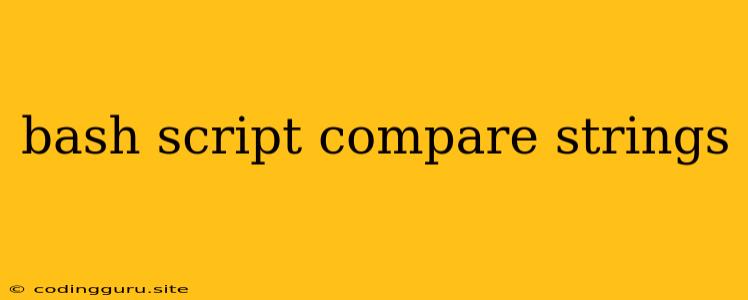Comparing Strings in Bash Scripts: A Comprehensive Guide
Bash scripting is a powerful tool for automating tasks on Linux and macOS systems. One common task is comparing strings, which can be used for a wide range of purposes, from validating user input to performing conditional actions. In this guide, we will explore different methods to compare strings in your bash scripts.
Understanding the Basics
At its core, comparing strings in bash involves using comparison operators. These operators evaluate the relationship between two strings and return a boolean value, either true or false.
Here are the most common comparison operators used for strings in bash:
==: Checks if two strings are exactly equal.!=: Checks if two strings are not equal.<: Checks if the first string is lexicographically less than the second string.>: Checks if the first string is lexicographically greater than the second string.-z: Checks if a string is empty.-n: Checks if a string is not empty.
Methods for Comparing Strings
Let's dive into practical examples of how to use these operators in your bash scripts.
1. Simple String Comparison
This example demonstrates comparing two strings using the == operator.
#!/bin/bash
string1="hello"
string2="world"
if [ "$string1" == "$string2" ]; then
echo "The strings are equal."
else
echo "The strings are not equal."
fi
In this script, we assign "hello" to string1 and "world" to string2. The if statement uses the == operator to check if the two strings are equal. Since they are not, the else block is executed, printing "The strings are not equal."
2. Comparing with Regular Expressions
Bash offers powerful capabilities for string comparison using regular expressions. The =~ operator allows you to check if a string matches a given regular expression.
#!/bin/bash
string="This is a test string."
if [[ "$string" =~ "test" ]]; then
echo "The string contains 'test'."
else
echo "The string does not contain 'test'."
fi
Here, we use the =~ operator to check if string contains the substring "test". Since the pattern matches, the if block executes, printing the message.
3. Checking String Length
The -z and -n operators are helpful for determining if a string is empty or not.
#!/bin/bash
string1=""
string2="Hello"
if [ -z "$string1" ]; then
echo "String1 is empty."
fi
if [ -n "$string2" ]; then
echo "String2 is not empty."
fi
In this example, string1 is empty, while string2 contains "Hello". The -z operator confirms string1 is empty, and the -n operator confirms string2 is not empty.
4. Lexicographical Comparison
The < and > operators allow you to compare strings lexicographically (alphabetically).
#!/bin/bash
string1="apple"
string2="banana"
if [ "$string1" < "$string2" ]; then
echo "String1 is lexicographically less than String2."
else
echo "String1 is not lexicographically less than String2."
fi
This example demonstrates comparing "apple" and "banana" lexicographically. Since "apple" comes before "banana" alphabetically, the if block executes, printing the message.
Tips for Effective String Comparison
- Quotes are essential: Always enclose your strings in double quotes (
") to prevent unexpected behavior caused by special characters or whitespace. - Consider case sensitivity: If you need to compare strings in a case-sensitive manner, use the
[[ ]]double brackets, which support case-sensitive comparisons by default. - Use regular expressions: For more complex pattern matching, leverage regular expressions with the
=~operator. - Test thoroughly: Always test your scripts with various input values to ensure they function correctly in different scenarios.
Conclusion
Comparing strings is a fundamental operation in bash scripting. Understanding the different comparison operators and their uses is crucial for building robust and reliable scripts. By applying the techniques discussed in this guide, you can confidently handle string comparisons in your bash scripts for tasks like data validation, input processing, and conditional logic.
